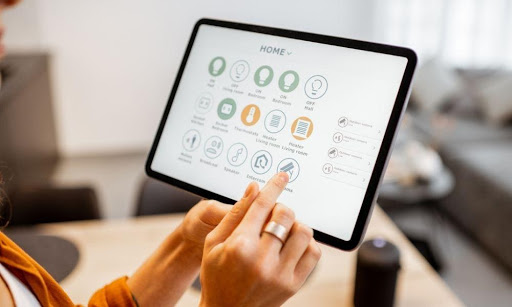Ways Technology Has Affected Interior Design

Technology has affected many professional services, including interior design. Designers and their clients benefit from new tools and technical advances that enhance convenience, support innovation, and demand new ways of thinking about how to organize and beautify interior spaces. Here are some of the many ways technology has affected interior design.
Smart Homes
Lighting, thermostats, appliances, and security systems that respond to voice commands, face recognition, fingerprints, or remote signals from cellphones require designers and their clients to rethink how they will use space and place furniture in the home. Motion and heat sensors might control when lights brighten or dim, and when heating or cooling systems kick in. Interior designers must consider where to place switches, control panels, televisions, and speakers to integrate smart elements seamlessly in the space.
Smart homes and devices require fast and reliable networks, and interior designers must coordinate with architects and ISPs to determine how to supply connectivity to and within structures. Designers and their clients must let go of misconceptions about fiber-optic cables because high-speed networks run best over them. Switches, routers, and converters that transform optical signals into electrical signals all affect how many and what kind of ports and connections designers should plan for individual living spaces.
Virtual and Augmented Reality
Clients already have access to simple forms of augmented reality through apps that superimpose images or graphics of furniture or light fixtures onto photos of existing rooms. With virtual reality, special goggles enable clients and designers to enter a virtual space and experience what it would look like with new or rearranged furniture, colors, and patterns. Virtual reality enables an immersive, 360◦ tour of a proposed interior environment. Apps turn cellphones into measuring and visual modeling devices, allowing creative homeowners to upload images of their space; reimagine it with new furniture, fabrics, and colors; and then purchase their chosen items from a pool of retailers or suppliers.
3D Printing and Collaborative Design
Prototyping reaches new levels of convenience and creativity with 3D printing. Designers can inexpensively test ideas and create furniture to exact specifications without compromise. Soon, designers and architects will produce furniture and even entire homes through 3D printing.
Clients can use online services to search for designers through matching services that consider the desired mood and aesthetic, match clients to designers, and supply plans and even shopping lists. Designers working in locations across the globe can now easily collaborate to develop plans and prototypes for residential and commercial projects.
Technological innovations continue to affect interior design and other creative professions. New apps, software, imaging technologies, smart furniture, and fixtures—plus high-speed network expansion—save time and money and will continue to transform interior spaces in previously unimagined ways.





